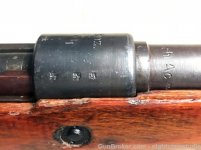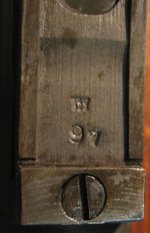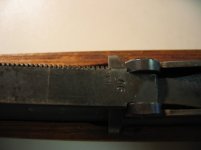In reading about Steyr made rifles it seemed that they suffered from quality issues which only got worse as the war went on, is that a fair statement to make and does it make them less desirable to collectors. There is not a lot data in the stickies about Steyr. It also seems alot of people think they were sole provider to the SS.

You are using an out of date browser. It may not display this or other websites correctly.
You should upgrade or use an alternative browser.
You should upgrade or use an alternative browser.
Steyr quality
- Thread starter rtr091112
- Start date
Collecting is about personal preference. Some guys like the commercial quality prewar stuff, while others like the late war stuff that looks like it was finished off with a bastard file. So, a nice 45 Steyr can bring a good chunk more of money than a midwar gun from a common maker, while a prewar can be very expensive for its own reasons.
But yea, Steyr quality got comically bad towards the end, more so than the other makers IMO. Have you seen the picture reference thread?
http://www.k98kforum.com/showthread.php?45-Picture-Reference-Index
But yea, Steyr quality got comically bad towards the end, more so than the other makers IMO. Have you seen the picture reference thread?
http://www.k98kforum.com/showthread.php?45-Picture-Reference-Index
ltong29
Senior Member
Steyr did okay work pre-WW2. I wouldn't compare the finish and polish jobs to Mauser-Oberndorf. In my picture, you can see the pre-war rifles were polished to a pretty high degree and have a pretty nice finish. The BNZ 42 on the other hand wasn't polished to the same degree and you can see
machine marks on it.

machine marks on it.

Last edited:
heavy_mech
RKI- Reasonably Knowledgable Individual
At the very end it was comical, even for them. In the s and t blocks you can really see it coming apart. The bolt collar, bolt handles and front bands get especially bad. Stock chatter gets really bad too. Check the bolt collar in particular in this very late example.
http://www.k98kforum.com/showthread.php?115-bnz-45-6403-T
I'll add this. I think 30+ years before their quality and finish was very good.
http://www.k98kforum.com/showthread.php?115-bnz-45-6403-T
I'll add this. I think 30+ years before their quality and finish was very good.
tsmgguy
Senior Member
Early war 660 & BNZ coded MP-40s were very well made and finished.
We might not much care for the quality of fit and finish on the late war guns, but they were functional for their intended purpose, were safe to shoot, and were made of quality materials. The short cuts were taken only to increase production rates. Why spend a great deal of time on finishing when the combat career of the gun and its bearer would likely be measured in minutes?
The US was the only major combatant that did not adopt this approach, and so never had reason to regret the decision. By regulation, no fitting was allowed during the manufacture of US small arms. All parts were perfectly interchangeable from the beginning of serial production to the end.
We might not much care for the quality of fit and finish on the late war guns, but they were functional for their intended purpose, were safe to shoot, and were made of quality materials. The short cuts were taken only to increase production rates. Why spend a great deal of time on finishing when the combat career of the gun and its bearer would likely be measured in minutes?
The US was the only major combatant that did not adopt this approach, and so never had reason to regret the decision. By regulation, no fitting was allowed during the manufacture of US small arms. All parts were perfectly interchangeable from the beginning of serial production to the end.
Kammerjaeger
Well-known member
I have been told, by multiple sources, that many bnz45’s had significant heat treat issues.
KJ
KJ
ltong29
Senior Member
Steyr had a high rate or rejection in 1941, so standards were relaxed in order to increase accepted production. This is a 1938 660 G29ö vs a 1942 BNZ K98k.
Receivers side by side. As I mentioned before, in order to expedite receiver production at Radom, the receivers weren't polished to the same degree they were pre-war.


Also, the amount of times a receiver was inspected during manufacturing was decreased. Pre-war, there were 3 receiver, indicated by the 3x 623 Waffenamts. In 1942, it was done just once, indicated by the 1x E/77.


Small parts also ceased to be inspected


I don't have a late war/kreigsmodell to compare it to, but I think this kind of tells the story.
Receivers side by side. As I mentioned before, in order to expedite receiver production at Radom, the receivers weren't polished to the same degree they were pre-war.


Also, the amount of times a receiver was inspected during manufacturing was decreased. Pre-war, there were 3 receiver, indicated by the 3x 623 Waffenamts. In 1942, it was done just once, indicated by the 1x E/77.


Small parts also ceased to be inspected


I don't have a late war/kreigsmodell to compare it to, but I think this kind of tells the story.
ac4142
Well-known member
makes sense. this bnz41 (totally awesome and 1 of the coolest rifles i have ever seen) has 4 WaA. what is the 4th one for? correct headspace? http://www.k98kforum.com/showthread.php?30343-Walnut-KM-BNZ41
ltong29
Senior Member
Steyr is kinda weird when it came to markings. I speculate since Steyr was notorious for poor passing rate with K98k production in 1940 and 1941, they may have internally instituted a 4th waffenamt inspection to try and improve their passing score. Most manufacturers only have 3 waffenamt along the right of the receiver. The only exception I can think of is Gustloff. They typically have 4. However, I think 1 of the waffenamts is from Astrawerke and Gustloff merely double checked the Astrawerke receivers before assembly
sturmgrenadier
Senior Member
Early war 660 & BNZ coded MP-40s were very well made and finished.
We might not much care for the quality of fit and finish on the late war guns, but they were functional for their intended purpose, were safe to shoot, and were made of quality materials. The short cuts were taken only to increase production rates. Why spend a great deal of time on finishing when the combat career of the gun and its bearer would likely be measured in minutes?
The US was the only major combatant that did not adopt this approach, and so never had reason to regret the decision. By regulation, no fitting was allowed during the manufacture of US small arms. All parts were perfectly interchangeable from the beginning of serial production to the end.
The only exception to this in regards to US manufacturing would be Winchester. Apparently their quality control was poor. Winchester Garand rifles had interchangeability problems which led to issues with rebuilding and hand fitting. They ultimately lost the contract for the M1 Garand and IHC and HRA took over some of the production.
Here are some pics of a sporterized T-block Steyr I had briefly back in 2007. I'm guessing it was made in the last few weeks of the war.
Attachments
Last edited:
Bigdibbs88
"Ach du lieber!"
Steyr got pretty gross but I’d put my 660 1939 up against any Mauser oberndorf. Buttery smooth with excellent bluing, almost seems like a pradox when compared to my other Steyrs.










